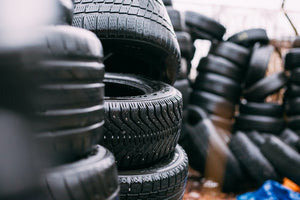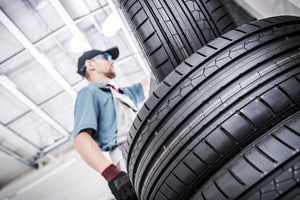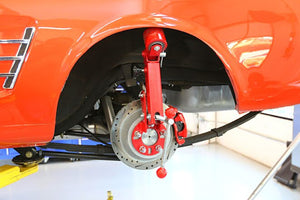
Braking the Silence: Do You Need New Brakes?
When it comes to cars, being able to stop is more important than being able to go. If you think about it, the only thing stopping your precious baby from hitting the tire wall are your brakes: four tiny, circular pieces of steel connected to four calipers.

With this in mind, upgrading your brakes to ensure your safety (and survival) is probably the best decision you can make for your build. But what does upgrading your brakes even mean?
Upgrading your brakes is about making them more effective at their job. To put it simply, you upgrade your brakes with two simple goals in mind: to shorten the braking distance, and minimize the brake fade.
Braking distance? Brake fade? What? Let’s define these concepts before going any further.
Braking Distance

Braking distance is the distance your car travels from full speed to a dead stop. Shortening that brake distance means that you have a higher likelihood of not crashing into anything in an emergency braking situation.
For racing drivers, though, a shorter braking distance translates into an opportunity to brake later than the competition. Having confidence that you can do that can sometimes make or break your race.
__
Brake Fade
On the other hand, brake fade is what happens when your brakes no longer work at their best. Normally, hard braking isn’t done except in emergency situations, but on the track, hard, progressive braking is a constant and a necessity.
Brakes are heated and cooled constantly; and this rapid heating and cooling makes it more difficult for the calipers to grip onto the rotors. Upgrading your brakes to minimize brake fade makes your brakes more reliable in a long race.
__
What to Consider When Changing Your Brakes
So, you’ve decided to upgrade your brake kit. Great! What do you do now?
The first thing you need to ask yourself is whether the brakes will clear your wheels.

Upgrading your brakes usually means going for larger diameter discs and bigger calipers. Bigger discs have more surface area for calipers to grip onto, and the bigger calipers mean that there’s more available pressure for them to grip onto the discs.
The upside to having a larger brake is that you can stop on a dime; this gives the driver more confidence. The potential problem is that a big brake kit might not clear your car’s stock wheels.
Generally speaking, for your brakes to clear your wheels, you need to look at where your brake disc and calipers sit in relation to your wheel barrel, or the inside of your wheels.
If the bottom of the brake disc is too close to the barrel, it could rub and cause issues with your wheels down the line, potentially dooming your wheel to a life of vibrations while driving.
With larger wheels, your brake caliper may also end up touching the barrel, or the portion of the wheel that fits flush to the hub. Contact between any of these will compromise the material and strength of the wheel, the barrel, or the caliper; and that could cause any of these three to fail over time.
Brake Clearance

Once you’ve decided on what kind of brake kit you want to purchase, the next thing you need to do is test fit and measure them against your current wheel. These measurements are essential to your brake clearance, and as such, you would be remiss if you didn’t do your homework. Measure them once, or even twice, rotate them around to make sure you have enough clearance against your current set of wheels.
Disc Diameter and Caliper Size

The first thing you should measure is the diameter of the brake rotor and caliper. It is safe to assume that this diameter will be larger than your standard brake kit, so finding out exactly how much larger is essential.
Normally, aftermarket companies design performance brakes to complement a specific dimension of wheel, and this is usually the stock wheel size. For example, if Porsche designed the 911 for 23 millimeter rotors, aftermarket companies like AP Racing probably design a brake set very close to that exact specification.
Companies can and should make that information known. But even a conversation with a specialist at your local O’Reilly or Advance Auto shops should clarify things for you.
__
Stage 1 Upgrade

After figuring out the kind of clearances you have, you can start looking into the kinds of upgrades available for your particular make and model. When it comes to something as crucial as brakes, there is no universal kit that’s one-size-fits-all.

One option is to go for a simple upgrade kit: This type of kit usually includes a meatier brake rotor and upgraded brake pads. Meatier brake rotors usually mean getting a bigger caliper, too. Bigger rotors mean a bigger diameter and an increased thickness. Given advancements in braking technology, these brakes will also be ventilated. Like your stock brakes, they have an internal structure that allows them to be cooled (instead of the rotor being a solid piece of metal).
The advantage of choosing this first option, often referred to as a Stage 1 Upgrade, is that these brakes tend to perform better than ordinary stock brakes. In other words, a Stage 1 Upgrade will enable you to stop better and experience less brake fade.
The disadvantages to choosing this option are minimal and to be expected. First, this upgrade kit is more expensive than stock brakes, and if they’re damaged by sand or rocks that get stuck between the rotor and one of the calipers, it will cost more to repair.
Slotted Brakes

Slotted brake rotors offer an interesting looking brake package and are designed with a better heat dissipation system. Better heat dissipation means less brake fade over time, which means they perform better.
In addition to improving your car’s performance, slotted rotors also look really cool behind a properly styled set of wheels. Yes, safety is cool.
For some people, however, Stage 1 isn’t enough.
Carbon Ceramic Brakes

Carbon ceramic brakes are a popular modification today. Carbon ceramic brakes are exactly what their name suggests: brakes that use a compound of carbon and ceramic in the production of the brake rotors.
If you’ve been following racing for the last 10 years, you know that most supercars are equipped with these brakes. This alone should tell you that carbon ceramic brakes are as cutting edge as you can get when it comes to braking. Famous examples include the Mercedes McLaren SLR from the early 2000’s, all the way up to the mind boggling LaFerrari.
What makes these brakes so good is that they are very good at minimizing brake fade. That is important because it means your car will brake the exact same way, whether you’re on lap 1 or lap 15.
These brakes are made specifically for high-performance racing. Although a cool thing to have (or boast that you have) on your street car, they are really only necessary if you’re a serious racer. These may be overkill if you don’t plan to use your vehicle on the track. Let me explain.
One reason for that is that the performance it offers might be too much for the average builder. Part of what makes these brakes so good is their ability to perform at high temperatures. Carbon Ceramic Brakes are designed to reach high heat levels without sacrificing brake force, and they do this extremely well. The downside is that they only work their best at high temperatures.
Another downside to Carbon ceramic brakes is their race-derived braking properties. They were designed to stop a 1.5 ton supercar from close to 150mph to a dead stop in as short a distance as possible, so imagine that kind of stopping power being used at a mere 30mph. Your capacity to modulate your brakes must be on point, otherwise your ride won’t be as comfortable as you might wish.
Since they are made to be used in supercar racing, carbon ceramic brakes are also extremely expensive. For example, certain German sports car manufacturers can charge up to $21,000 for a set of these brakes.

Although these brakes are more durable than most, they’re not indestructible. It would take a massive amount of abuse to severely damage them; yet, if they do get damaged, it will cost a lot to repair them – well into five figures. That’s another cost to consider, especially since these will experience a harder life than street brakes.
__
Fitting the New Brakes
After measuring the diameter of the rotor and the size of the caliper, you must now turn to the easy part: putting them on your vehicle.
When assembled, the Rotor fits onto a rotating assembly by way of a few bolts, and the Caliper “floats” on the Rotor courtesy of a bracket that is attached usually to the suspension’s control arms. In a way, the two move separately from each other, but it isn’t immediately noticeable.
How much the caliper “floats” over the rotor differs between manufacturers, so to measure this, you can place the caliper on top of the rotor, and add a few millimeters to that measurement.
__
The Right Wheel Size to Clear The Brakes
Next, you need to measure your wheels, or specifically, your offset. What is offset, you may ask?
There is a long and convoluted explanation of what offset is, but the short and sweet of it is that offset is how “deep” your wheels are. If we define it more, the offset is the measurement between the outer rim of your wheel to the back spacing, or the part of the wheel which is in contact with your hub. If you take the examples of a typical steel wheel, which has an offset typically close to 0, and a “deep dish” wheel, which can go all the way to and beyond -45, which means the wheel has negative offset.

How does something like offset relate to the brakes you buy, though? Well, in some instances, the offset of your wheel can cause clearance issues with your calipers - the inside of your spokes rubbing on metal and causing damage to either the caliper or more likely the wheel itself. This can result in sheared off spokes and general mayhem, should this happen on a public street.
The only real way to solve this is to get in there with a feeler gauge and check your clearances once you’ve fitted your new calipers and wheels. Generally speaking, maintaining the offset of your wheels will mean you won’t run into this issue, but as a rule of thumb, it would be best to limit your choices to within +/- 15mm of offset from stock.
Finally, you need to measure to see if the back spacing of the wheel will clear the bottom of the caliper. Sometimes, the metal on this part of the wheel will come in contact with the bottom of the caliper. A simple way to avoid this issue is to use a spacer to extend the wheel past the caliper a little more.
__
Are Brake Upgrades Worth it?

After tackling the pros and cons of upgrading your brakes, and the potential issues you might run into, you must now answer the simple question: should you or should you not upgrade your brakes?
Why shouldn’t you?
Safety is of course the main reason for upgrading your brakes. And though not everyone can afford to buy the most expensive kit, it’s one of those investments that every car owner must make at some point. Something as simple as buying uprated brake pads makes a world of difference in braking performance; and they’re cheap. It’s also a relatively easy mod that any auto shop can put on your car. And because replacing your brake pads is part of periodic maintenance, going for high quality brake pads means longer maintenance intervals for that particular consumable.
As stated above, this is an investment that will keep you — and anyone who rides with you — safe. In addition, good brakes will also improve your driving performance. Having the security of good brakes means knowing that when things go wrong, you can at least minimize the damage to yourself and to your car.
As enthusiasts, we invest a lot in our rides. Having bad brakes means risking this investment at every intersection. We never know when an inattentive driver will run a red light or swerve into our path.

If you go on the track with bad brakes, you not only put yourself in danger, you put others in danger as well. If you’re unable to stop in time for the corner, more often than not, the car will simply fail to turn, and will either hit the wall, run into the grass, or worse, T-Bone another driver.
Whenever you start to doubt your car’s ability to brake, it’s time to upgrade your brakes. When that time comes, knowing how to go about it is essential. Both builders and buyers need to do their research and choose the brake setup that will keep them safe and help them perform optimally on the track.







